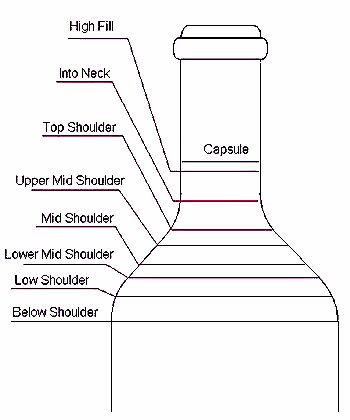The filling level of wine bottles
The fill level - an important parameter for wine rarities,
Wine connoisseurs understand the filling level to be the height of the liquid level in a wine bottle. In newly filled bottles, the distance between the cork and the fill level is very small. During storage, the connection between the natural cork and the neck of the bottle is never one hundred per cent tight, so there is usually some slight shrinkage due to evaporation, as even the highest quality cork is not completely elastic.
With proper storage and a high-quality cork, the probability of evaporation is significantly lower. No significant loss of liquid should occur in the first 10 years.

Here are the technical descriptions of the fill level.
Fill levels for Bordeaux bottles:
"High Fill" ("h.f.") - no visible loss of liquid.
"Into Neck" ("i.n.") or "Base Neck" ("b.n.") - means that the wine level is still the same width as when it was bottled.
"High Shoulder" ("h.s.") or "Top Shoulder" ("t.s.") - the neck is slightly wider. However, acceptable for wines older than 20 years.
"Upper Shoulder" ("u.s.") or "High Mid Shoulder" ("h.(t.)m.s.") - Point between "high" and "mid shoulder". Normal for a wine over 30 years old.
"Mid Shoulder" ("m.s.") - Filling level in the centre of the bottle shoulder, where it slowly becomes vertical. Natural shrinkage in wines over 40 years old.
"Low Shoulder" ("l.s.") - The end of the shoulder. This fill level is acceptable for rare and sought-after top wines.
"Below Shoulder" ("b.s.") - High risk of oxidation.
Other bottle shapes
For other bottle shapes such as Burgundy, Riesling, etc., it is difficult to describe the shoulder shape. Here, the fill level is measured by the distance between the liquid level and the lower edge of the cork. In addition, it should be noted that the fill level of a bottle has a considerably different significance for Burgundy in particular than for a Bordeaux wine, for example. For example, a fill level of 7 cm in a red Burgundy over 50 years old only indicates a relatively low risk. A fill level of less than 5 cm is excellent for such a wine.

